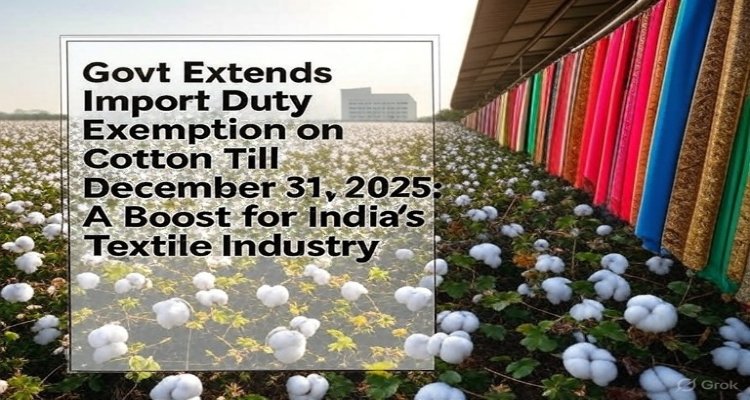Govt Extends Import Duty Exemption on Cotton Till December 31, 2025: A Boost for India’s Textile Industry
The Indian government extends the import duty exemption on cotton till December 31, 2025, to stabilize input costs, support textile exports, and safeguard employment.
Introduction
In a strategic move to support one of India’s most vital sectors, the government has extended the import duty exemption on cotton until December 31, 2025. This decision comes amid ongoing demand-supply challenges and follows the imposition of steep tariffs by the United States—the largest export market for India’s textile and apparel industry. The extension aims to sustain the availability of affordable, high-quality cotton, stabilize costs, and bolster India’s global competitiveness in textile exports.
Context and Background
India’s textile industry is the country’s second-largest employment provider, engaging over 45 million people across the textile and apparel value chain. Cotton, often referred to as “white gold,” is central to this sector, with 95 percent of domestic cotton consumed by textile mills. India is the world’s largest cotton producer by acreage and a key exporter of cotton textiles, accounting for about 33 percent of the country’s textile and apparel exports.
Rising global demand, fluctuating production, and the recent imposition of a 50 percent tariff by the US on Indian goods have created pressure points in the cotton supply chain. The government initially exempted cotton imports from an 11 percent combined import duty in August 2025 to ease raw material availability and input costs. The recent extension broadens this relief to the end of the year, enabling domestic manufacturers and exporters to better navigate global headwinds.
Main Developments
The Central Board of Indirect Taxes and Customs has announced the extension of the duty exemption on cotton imports, covering the 5 percent Basic Customs Duty, 5 percent Agriculture Infrastructure and Development Cess, and a 10 percent Social Welfare Surcharge, cumulatively removing an 11 percent import tariff.
This duty waiver facilitates lower raw material costs along the entire textile chain from yarn and fabric to finished garments and made-ups. It especially assists export-oriented units and small and medium enterprises by enabling access to cheaper international cotton during lean periods or when domestic supplies fall short. The government’s move is designed to uphold the stability of cotton prices, safeguard jobs, and prevent disruptions in textile production.
Expert Insight and Public Reaction
Textile industry associations have welcomed the government’s decision, citing it as a timely relief that supports both domestic manufacturers and exporters worried about the impact of US tariffs. Dr. S.K. Sundararaman, Chairman of the Southern India Mills’ Association (SIMA), noted that the duty exemption will not adversely affect cotton farmers since domestic production is below demand levels, ensuring that cheaper imports will complement rather than replace Indian cotton.
Chandrima Chatterjee, Secretary General of the Confederation of Indian Textile Industry (CITI), expressed optimism that the extension will allow the industry sufficient time to place fresh import orders necessary for sustaining production schedules and export commitments.
Impact and Implications
The import duty exemption is expected to stabilize input costs across the textile ecosystem, enhancing the global competitiveness of Indian textiles. By enabling mills to procure internationally sourced cotton at prices reportedly around 10 percent lower than domestic supplies, the exemption helps cushion the blow from the US tariffs. This measure indirectly benefits cotton farmers as globally competitive mills can offer better prices.
With cotton textile exports valued at approximately $7.08 billion during April-October 2024-25, representing a third of the country’s textile exports, the exemption is likely to contribute significantly to maintaining export volumes. It also aligns with broader government goals such as “Make in India” and sustaining domestic manufacturing growth.
Furthermore, the policy supports the livelihoods of six million cotton farmers and tens of millions employed in related trades like processing and garment manufacturing. By preventing job losses and encouraging industry expansion, the exemption reinforces the crucial socio-economic fabric woven around cotton production in India.
Conclusion
India’s extension of the import duty exemption on cotton until the end of 2025 demonstrates a well-balanced approach to safeguarding the interests of textile manufacturers, exporters, and farmers. By ensuring stable access to affordable, high-quality cotton, the government strengthens India’s position in global textile markets amid challenging international trade dynamics. This measure not only supports industry growth and employment but also reiterates India’s commitment to sustaining a robust and globally competitive textile sector.
Disclaimer: This article is based on publicly available government releases and industry insights as of August 2025.










